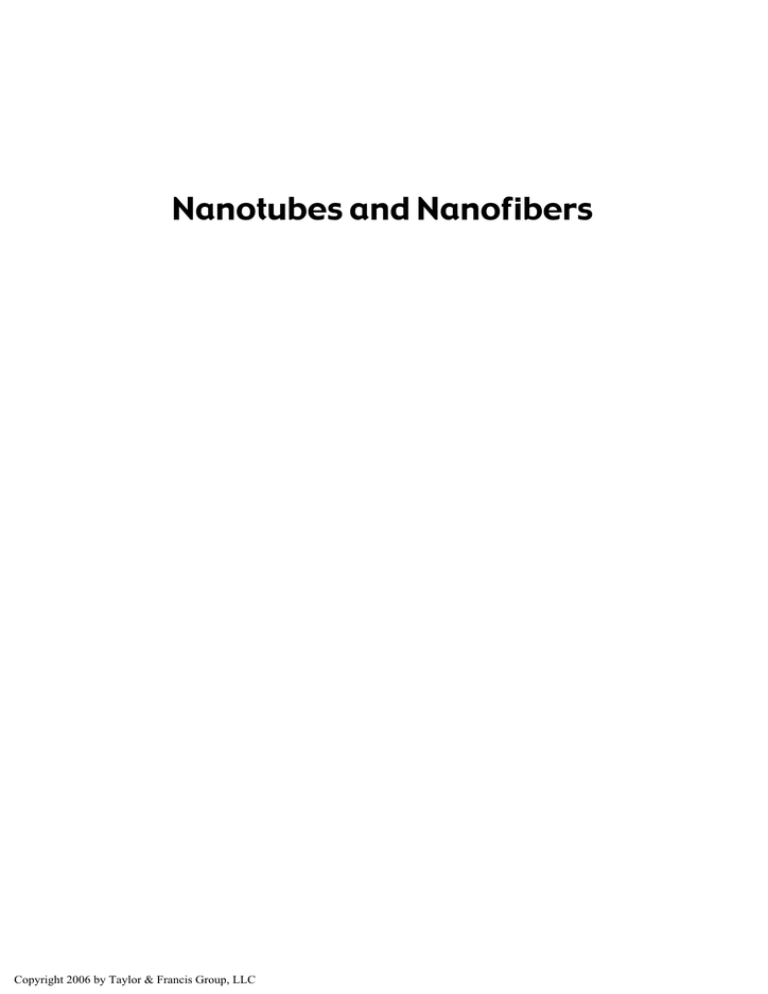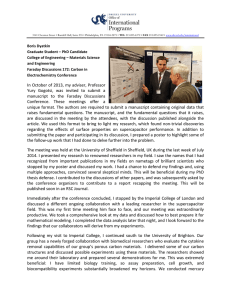Nanotubes and Nanofibers
advertisement

Nanotubes and Nanofibers Copyright 2006 by Taylor & Francis Group, LLC Advanced Materials Series Series Editor: Yury Gogotsi, Drexel University, Philadelphia, Pennsylvania, USA series includes: Carbon Nanomaterials Yury Gogotsi Nanotubes and Nanofibers Yury Gogotsi Copyright 2006 by Taylor & Francis Group, LLC Nanotubes and Nanofibers Edited By Yury Gogotsi Drexel University, Philadelphia, Pennsylvania, USA Boca Raton London New York CRC is an imprint of the Taylor & Francis Group, an informa business Copyright 2006 by Taylor & Francis Group, LLC This material was previously published in the Nanomaterials Handbook © 2006 by Taylor and Francis Group, LLC. CRC Press Taylor & Francis Group 6000 Broken Sound Parkway NW, Suite 300 Boca Raton, FL 33487-2742 © 2006 by Taylor and Francis Group, LLC CRC Press is an imprint of Taylor & Francis Group, an Informa business No claim to original U.S. Government works Printed in the United States of America on acid-free paper 10 9 8 7 6 5 4 3 2 1 International Standard Book Number-10: 0-8493-9387-6 (Hardcover) International Standard Book Number-13: 978-0-8493-9387-7 (Hardcover) Library of Congress Card Number 2006012338 This book contains information obtained from authentic and highly regarded sources. Reprinted material is quoted with permission, and sources are indicated. A wide variety of references are listed. Reasonable efforts have been made to publish reliable data and information, but the author and the publisher cannot assume responsibility for the validity of all materials or for the consequences of their use. No part of this book may be reprinted, reproduced, transmitted, or utilized in any form by any electronic, mechanical, or other means, now known or hereafter invented, including photocopying, microfilming, and recording, or in any information storage or retrieval system, without written permission from the publishers. For permission to photocopy or use material electronically from this work, please access www.copyright.com (http:// www.copyright.com/) or contact the Copyright Clearance Center, Inc. (CCC) 222 Rosewood Drive, Danvers, MA 01923, 978-750-8400. CCC is a not-for-profit organization that provides licenses and registration for a variety of users. For organizations that have been granted a photocopy license by the CCC, a separate system of payment has been arranged. Trademark Notice: Product or corporate names may be trademarks or registered trademarks, and are used only for identification and explanation without intent to infringe. Library of Congress Cataloging-in-Publication Data Nanotubes and nanofibers / Yury Gogotsi, editor. p. cm. Includes bibliographical references and index. ISBN 0-8493-9387-6 (978-0-8493-9387-7) 1. Nanotubes. 2. Nanostructured materials. I. Gogotsi, IU. G., 1961TA418.9.N35N3577 2006 620’.5--dc22 Visit the Taylor & Francis Web site at http://www.taylorandfrancis.com and the CRC Press Web site at http://www.crcpress.com Copyright 2006 by Taylor & Francis Group, LLC 2006012338 This book is dedicated to my father, Professor George Gogotsi, who inspired me to become a scientist. Copyright 2006 by Taylor & Francis Group, LLC Preface Nanomaterials, which are materials with structural units on a nanometer scale in at least one direction, is the fastest growing area in materials science and engineering. Material properties become different on the nanoscale: for example, the theoretical strength of materials can be reached or quantum effects may appear. One-dimensional and quasi-one-dimensional materials such as nanotubes and nanowires demonstrate many extreme properties that can be tuned by controlling their structure and diameter. Nanotubes, nanowires, and nanofibers are not only excellent tools for studying one-dimensional phenomena, but they are also certainly among the most important and promising nanomaterials and nanostructures. The role of nanomaterials in industries is growing. Nanofibers are already used for insulation and reinforcement of composites, and many materials and structures incorporating nanotubes and nanowires are under development. Extensions to other tubular and rodlike or wirelike structures provide the scope for new discoveries and novel applications. This book describes a large variety of nanotubes, nanofibers, and related structures such as whiskers and nanowires. This area is very broad; it is impossible to cover all fibrous nanomaterials in a single volume. Carbon nanotubes (Chapters 1 and 2) receive special attention in this book because carbon is as important for nanotechnology as silicon is for electronics. Sumio Iijima's discovery of carbon nanotubes in 1991 stimulated the development of the whole nanotechnology field. Since then, a dramatic progress in synthesis and purification of nanotubes has been achieved and many applications have emerged. After carbon, many other materials have been produced in the tubular shape with nanometer diameters. Designed specifically to provide an overview of nanotubes and nanofibers for today's scientists, graduate students, and engineering professionals, the book will offer a treatment of subjects using terms familiar to a materials scientist or engineer. The book consists of eight chapters selected from the recently published Nanomaterials Handbook and is written by the leading researchers in the field. Providing coverage of the latest material developments in the United States, Asia, Europe, and Australia, the book describes both commercially available and emerging materials. Finally, I would like to acknowledge all the people who have been helpful in making this book possible. My family was very patient and understanding, and my students and postdocs did a great job allowing me to concentrate on the book project. The staff of Taylor & Francis helped immensely. Yury Gogotsi Philadelphia, PA Copyright 2006 by Taylor & Francis Group, LLC Editor Dr. Yury Gogotsi is professor of materials science and engineering at Drexel University in Philadelphia, Pennsylvania. He also holds appointments in the Departments of Chemistry and Mechanical Engineering at Drexel University and serves as director of the A.J. Drexel Nanotechnology Institute and associate dean of the College of Engineering. He received his M.S. (1984) and Ph.D. (1986) degrees from Kiev Polytechnic and a D.Sc. degree from the Institute of Materials Science, Ukrainian Academy of Science, in 1995. His research group works on carbon nanotubes, nanoporous carbide-derived carbons, and nanofluidics. He has also contributed to the areas of structural ceramics, corrosion of ceramic materials, and pressure-induced phase transformations, creating a new research field called high pressure surface science and engineering. He has coauthored 2 books, edited 9 books, obtained more than 20 patents, and authored about 200 journal papers and 12 book chapters. He has advised a large number of M.S., Ph.D., and post-doctoral students at Drexel University and University of Illinois at Chicago. Gogotsi has received several awards for his research, including I.N. Frantsevich Prize from the Ukrainian Academy of Science, S. Somiya Award from the International Union of Materials Research Societies, G.C. Kuczynski Prize from the International Institute for the Science of Sintering, and Roland B. Snow Award from the American Ceramic Society (twice). He has been elected a fellow of the American Ceramic Society, academician of the World Academy of Ceramics, and full member of the International Institute for the Science of Sintering. Copyright 2006 by Taylor & Francis Group, LLC Contributors Ying Chen Department of Electronic Materials Engineering Research School of Physical Sciences and Engineering The Australian National University Canberra, Australia Svetlana Dimovski Department of Materials Science and Engineering Drexel University Philadelphia, Pennsylvania Fangming Du Department of Chemical and Biomolecular Engineering University of Pennsylvania Philadelphia, Pennsylvania John E. Fischer Department of Materials Science and Engineering University of Pennsylvania Philadelphia, Pennsylvania Yury Gogotsi Department of Materials Science and Engineering Drexel University Philadelphia, Pennsylvania Frank K. Ko Department of Materials Science and Engineering Drexel University Philadelphia, Pennsylvania Copyright 2006 by Taylor & Francis Group, LLC Eduard G. Rakov D.I. Mendeleev University of Chemical Technology Moscow, Russia Jonathan E. Spanier Department of Materials Science and Engineering Drexel University Philadelphia, Pennsylvania R. Tenne Department of Materials and Interfaces Weizmann Institute Rehovot, Israel Karen I. Winey Department of Materials Science and Engineering University of Pennsylvania Philadelphia, Pennsylvania Hongzhou Zhang Department of Electronic Materials Engineering Research School of Physical Sciences and Engineering The Australian National University Canberra, Australia Table of Contents Chapter 1 Carbon Nanotubes: Structure and Properties................................................................1 John E. Fischer Chapter 2 Chemistry of Carbon Nanotubes ................................................................................37 Eduard G. Rakov Chapter 3 Graphite Whiskers, Cones, and Polyhedral Crystals ................................................109 Svetlana Dimovski and Yury Gogotsi Chapter 4 Inorganic Nanotubes and Fullerene-Like Materials of Metal Dichalcogenide and Related Layered Compounds.............................................................................135 R. Tenne Chapter 5 Boron Nitride Nanotubes: Synthesis and Structure..................................................157 Hongzhou Zhang and Ying Chen Chapter 6 Nanotubes in Multifunctional Polymer Nanocomposites.........................................179 Fangming Du and Karen I. Winey Chapter 7 One-Dimensional Semiconductor and Oxide Nanostructures..................................199 Jonathan E. Spanier Chapter 8 Nanofiber Technology...............................................................................................233 Frank K. Ko Copyright 2006 by Taylor & Francis Group, LLC



